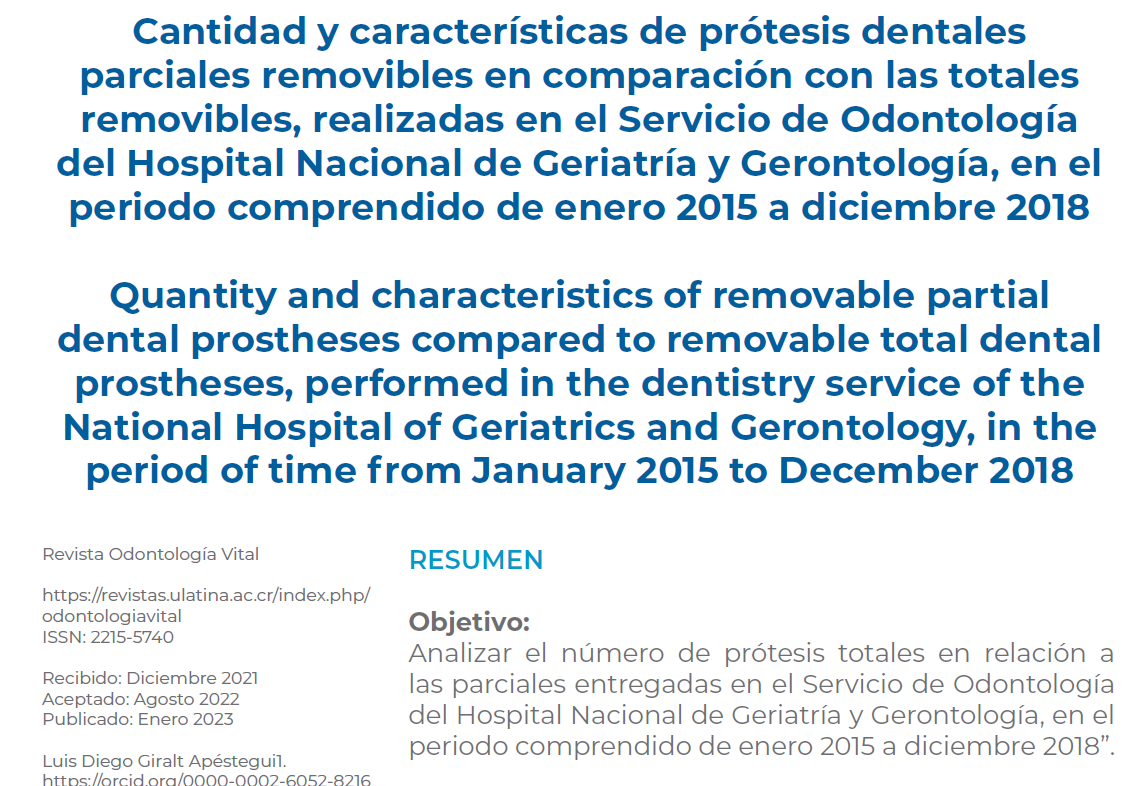Quantity and characteristics of removable partial dental prostheses compared to removable total dental prostheses, performed in the dentistry service of the National Hospital of Geriatrics and Gerontology, in the period of time from January 2015 to Decemb
DOI:
https://doi.org/10.59334/ROV.v1i38.546Keywords:
Dental Prosthesis, HRBC, Seleccionado: partial prosthesis , Total prosthesisAbstract
Objective: To analyze the number of total prostheses in relation to the partial ones delivered in the Dental Service of the National Hospital of Geriatrics and Gerontology, in the period from January 2015 to December 2018. The Dental Service of the HNGG provides the service of making dental prostheses on a national scale. The purpose of this study is to compare and analyze the number of total prostheses in relation to the partial ones delivered in the Dental Service of the National Hospital of Geriatrics and Gerontology, in the period from January 2015 to December 2018.
Methodology: The number of prostheses studied was 9,170. The study is non-experimental, descriptive, retrospective, where non-manipulable situations are observed, based on the official records of the dental laboratory and clinic.
Results: 60% of total dentures and 40% of removable partial dentures and 50% A2 color, 44% A1 color and 6% A3 color.
Discussion: In this center, more total dentures are being made than partial dentures, highlighting the deterioration of oral health in the elderly population.
Main results: Characteristics of the prostheses made by the Dentistry Service of the National Hospital of Geriatrics and Gerontology were: 60% of total dentures and 40% of removable partial dentures and 50% A2 color, 44% A1 color and 6% A3 color.
Main conclusions: Currently, more removable total dentures are being made than removable partial dentures, on average 60% to 40%. The colors most requested by patients are white tones.
Downloads
References
Tallgren, A. (2003). The continuing reduction of the residual alveolar ridges in complete denture wearers: aof mixed-longitudinal study covering 25 years. The Journal of Prosthetic Dentistry, 89(5), 427–435. https://doi.org/https://doi.org/10.1016/S0022-3913(03)00158-6
Davenport, J., Basker, R., Heath, J. et al. Communication between the dentist and the dental technician. Br Dent J 189, 471–474 (2000). https://doi.org/10.1038/sj.bdj.4800803
Davenport, J., Basker, R., Heath, J. et al. Initial prosthetic treatment. Br Dent J 190, 235–244 (2001). https://doi.org/10.1038/sj.bdj.4800936
Davenport, J., Basker, R., Heath, J. et al. The removable partial denture equation. Br Dent J 189, 414–424 (2000). https://doi.org/10.1038/sj.bdj.4800787

Downloads
Published
License
Copyright (c) 2023 Luis Diego Giralt Apéstegui, Alejandra Vargas Quesada

This work is licensed under a Creative Commons Attribution 4.0 International License.
Authors who publish with Odontología Vital agree to the following terms:
- Authors retain the copyright and grant Universidad Latina de Costa Rica the right of first publication, with the work simultaneously licensed under a Creative Commons Attribution 4.0 International license (CC BY 4.0) that allows others to share the work with an acknowledgement of the work's authorship and initial publication in this journal.
- Authors are able to enter into separate, additional contractual arrangements for the non-exclusive distribution of the Odontología Vital's published version of the work (e.g., post it to an institutional repository or publish it in a book), with an acknowledgement of its initial publication.
- Authors are permitted and encouraged to post their work online (e.g., in institutional repositories or on their website) prior to and during the submission process, as it can lead to productive exchanges, as well as earlier and greater citation of published work.






